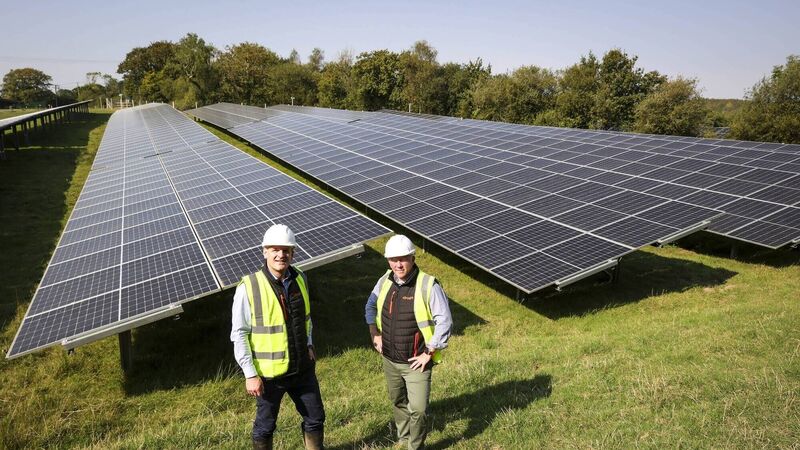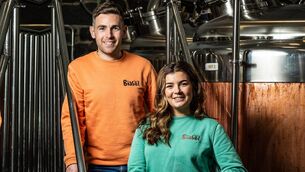Solar could be a silver bullet for Irish renewables

Business 26092024. No Repro Fee. Circal, a leading developer of solar and energy storage projects, today announced that it has secured €15 million from Octopus Energy Generation. This investment will drive Circal’s current sustainability projects and accelerate its growth ambitions for clean energy projects in Ireland and the USA. Founded by energy transition industry veterans Bill Sadlier and Seán Manley, Circal is a developer of utility-scale solar and energy storage projects. Its team has 4.5GW combined capacity of active projects in its pipeline in Ireland and the USA. Pictured are Sean Manley, Chief Operating Officer, Circal and Bill Sadlier, Chief Executive, Circal . Photo: Fennell Photography
Solar energy has quickly become a silver bullet for the renewables sector as residential and commercial customers can avail of grants to install panels and subsequently get cheaper clean electricity and not suffer the same planning backlogs that wind projects often become entangled in.
Consequently, several companies have grown substantially on the back of the increasing interest in solar, especially in an age of energy volatility. One of these is Circal.
“As an island there are huge opportunities in terms of wind energy, however, with one of the largest areas of suitable land in the world on a relative scale, solar energy almost eclipses wind energy opportunities to meet our energy demand and targets for 2030,” said Circal chief executive Bill Sadlier.
“It’s cheaper, quicker and critically, easier to connect to the grid,” he continued.
Circal recently received a €15m cash injection from investment vehicle Octopus Energy Generation which Mr Sadlier said reflects confidence in the Irish renewable energy market.
“The solar energy market in Ireland is growing, and rightly so. Clean energy solutions provide power for the needs of citizens and businesses right across the country that are renewable, zero emission and avoid polluting the atmosphere,” said Mr Sadlier.
Circle is a fully founded and owned Irish company and it is currently developing a portfolio of 16 projects from which we expect to deliver 1 gigawatt (GW) to the Irish power system by 2030.
He indicated that there is a key area that Circal is eyeing for further growth in the solar market - Farming.
Farmers have come under scrutiny in recent years to make their land more sustainable and energy efficient and companies like Circal have noticed this gap in the market.
In some cases, mainly on land used to farm sheep, the livestock and the solar panels co-exist and have dual benefits, according to reports from across Europe.
The solar panels provide shade and shelter while the livestock eat around the panels, preventing overgrowth.
“We are in the process of talking to some landowners and farmers across the country and the feedback is extremely positive,” said Mr Sadlier.
Circal is currently working on three projects in Cork relating to customers in this demographic and Mr Sadlier.
“It is incredibly interesting to hear the stories from farmers and landowners and the reasons they are diversifying to solar energy on their land, both in small quantities and at scale,” he said.
Mr Sadlier suggested that solar panel installation is becoming increasingly important in terms of succession planning on family farms, be it for sustainability reasons or to put the land to another use.
“Sons and daughters have career paths mapped out and the family farm is not on their radar. To give you on example on this, we are working with a son and daughter of a farming family whose parents have both passed, neither wanted to take on the work for the limited return, and also give up their careers. They sold the animals and contacted us to see if we could collaborate,” said Mr Sadlier.
However, Tánaiste Micheál Martin hit out at the collaboration between solar companies and landowners and was quoted in the Irish media recently saying “40 shades of green being replaced with 40 shades of grey”.
Industry representative body the Irish Solar Energy Association (ISEA) responded to the concerns and claimed meeting the Government's solar targets will require just around 0.2% of Ireland’s agricultural land area, ensuring agricultural productivity is largely unaffected.
Meanwhile, solar is not immune to some of the challenges facing developers in this sector including grid connectivity and a contentious planning system.
An outdated grid, which has led to cost complications to connect a project to the grid, is at the top of Mr Sadlier’s list of obstacles.
“There are also challenges with the planning system and availability of contractors to build out projects, however these challenges are not insurmountable and projects that are well planned and scoped from the outset will have the best chance of ultimately getting built,” he said.
In September the utilities regulator known as CRU published its Electricity Connection Policy – Generation and System Services (ECP-GSS), which signalled major changes to how renewable energy projects like solar will connect to the grid in Ireland.
This so-called ‘new connections policy’ will replace the Enduring Connection Policy (ECP-2), and it comes after extensive feedback from stakeholders, including ISEA, in a consultation earlier this year.
Among the recommendations from the ISEA that made it into the policy was to open at least one connection window in 2024 and two thereafter.
This was suggested to ensure continuous progress, and the ISEA recommended that at least one connection window be opened in 2024, followed by two annual windows in subsequent years.
For this year, just one connection batch was made available, from October 1 to November 30 under the existing ECP-2 process. Then, in September 2025, the new ECP-GSS policy kicks off with a single connection batch.
There’ll be changes to the process and timing for constraint reports; and work is set to continue to expand the renewable hubs pilot scheme for future inclusion in the connection process, according to the ISEA.
By 2026, bi-annual batches will start, giving developers two chances each year to apply.
Elsewhere, Mr Sadlier indicated the solar industry would like to see further changes to the State’s onshore renewable energy auctions known as Ress but recent alterations have contributed to developments.
“Though the industry would like to see further changes to the Ress structure, there have been some positive amendments implemented since the first auction,” he said.
Developers were provided with more certainty and reduced risk when bidding in recent auctions which avoided the scenario from the first and second auctions “where a large percentage of successful projects didn’t get built under the support scheme”, Mr Sadlier said.
In the most recent onshore renewable energy auction there were 27 successful applicants and 23 of these are in solar energy.
Professional services firm KPMG recently said the success of future Ress auctions require significant improvements in the planning system and the electricity grid.
“Key industry voices continue to call for increased resourcing and improved systems in both national and local planning bodies as a necessity to deliver the target of 80% renewable energy by 2030,” KPMG said in a report.
It also warned Ireland’s electricity grid urgently needs significant investment and upgrade to enable the connection of new renewable energy assets.








